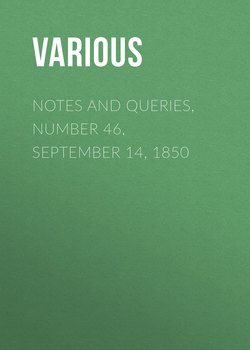Читать книгу Notes and Queries, Number 46, September 14, 1850 - Various - Страница 5
NOTES
FOLK LORE
ОглавлениеThe Legend of Sir Richard Baker (vol. ii., p. 67.).—Will F.L. copy the inscription on the monument in Cranbrook Church? The dates on it will test the veracity of the legend. In the reign of Queen Mary, the representative of the family was Sir John Baker, who in that, and the previous reigns of Edward VI. and Henry VIII., had held some of the highest offices in the kingdom. He had been Recorder of London, Speaker of the House of Commons, Attorney-General and Chancellor of the Exchequer, and died in the first year of the reign of Queen Elizabeth. His son, Sir Richard Baker, was twice high-sheriff of the county of Kent, and had the honour of entertaining Queen Elizabeth in her progress through the county. This was, most likely, the person whose monument F.L. saw in Cranbrook Church. The family had been settled there from the time of Edward III., and seem to have been adding continually to their possessions; and at the time mentioned by F.L. as that of their decline, namely, in the reign of Edward VI., they were in reality increasing in wealth and dignities. If the Sir Richard Baker whose monument is referred to by F.L. was the son of the Sir John above mentioned, the circumstances of his life disprove the legend. He was not the sole representative of the family remaining at the accession of Queen Mary. His father was then living, and at the death of his father his brother John divided with him the representation of the family, and had many descendants. The family estates were not dissipated; on the contrary, they were handed down through successive generations, to one of whom, a grandson of Sir Richard, the dignity of a baronet was given; and Sivinghurst, which was the family seat, was in the possession of the third and last baronet's grandson, E.S. Beagham, in the year 1730. Add to this that the Sir Richard Baker in question was twice married, and that a monumental erection of the costly and honourable description mentioned by F.L. was allowed to be placed to his memory in the chancel of the church of the parish in which such Bluebeard atrocities are said to have been committed, and abundant grounds will thence appear for rejecting the truth of the legend in the absence of all evidence. The unfortunately red colour of the gloves most likely gave rise to the story. Nor is this a solitary instance of such a legend having such an origin. In the beautiful parish church of Aston, in Warwickshire, are many memorials of the Baronet family of Holt, who owned the adjoining domain and hall, the latter of which still remains, a magnificent specimen of Elizabethan architecture. Either in one of the compartments of a painted window of the church, or upon a monumental marble to one of the Holts, is the Ulster badge, as showing the rank of the deceased, and painted red. From the colour of the badge, a legend of the bloody hand has been created as marvellous as that of the Bloody Baker, so fully detailed by F.L.
ST. JOHNS.
[Will our correspondent favour us by communicating the Aston Legend of the Holt Family to which he refers?]
Langley, Kent, Prophetic Spring at.—The following "note" upon a passage in Warkworth's Chronicle (pp. 23, 24.) may perhaps possess sufficient interest to warrant its insertion in your valuable little publication. The passage is curious, not only as showing the superstitious dread with which a simple natural phenomenon was regarded by educated and intelligent men four centuries ago, but also as affording evidence of the accurate observation of a writer, whose labours have shed considerable light upon "one of the darkest periods in our annals." The chronicler is recording the occurrence, in the thirteenth year of Edward the Fourth, of a "gret hote somere," which caused much mortality, and "unyversalle fevers, axes, and the blody flyx in dyverse places of Englonde," and also occasioned great dearth and famine "in the southe partyes of the worlde."
He then remarks that "dyverse tokenes have be schewede in Englonde this year for amendynge of mannys lyvynge," and proceeds to enumerate several springs or waters in various places, which only ran at intervals, and by their running always portended "derthe, pestylence, or grete batayle." After mentioning several of these, he adds—
"Also ther is a pytte in Kent in Langley Parke: ayens any batayle he wille be drye, and it rayne neveyre so myche; and if ther be no batayle toward, he wille be fulle of watere, be it neveyre so drye a wethyre; and this yere he is drye."
Langley Park, situated in a parish of the same name, about four miles to the south-east of Maidstone, and once the residence of the Leybournes and other families, well-known in Kentish history, has long existed only in name, having been disparked prior to 1570; but the "pytte," or stream, whose wondrous qualities are so quaintly described by Warkworth, still flows at intervals. It is scarcely necessary to add, that it belongs to the class known as intermitting springs, the phenomena displayed by which are easily explained by the syphon-like construction of the natural reservoirs whence they are supplied.
I have never heard that any remnant of this curious superstition can now be traced in the neighbourhood, but persons long acquainted with the spot have told me that the state of the stream was formerly looked upon as a good index of the probable future price of corn. The same causes, which regulated the supply or deficiency of water, would doubtless also affect the fertility of the soil.
EDWARD R.J. HOWE.
Chancery Lane, Aug. 1850.
